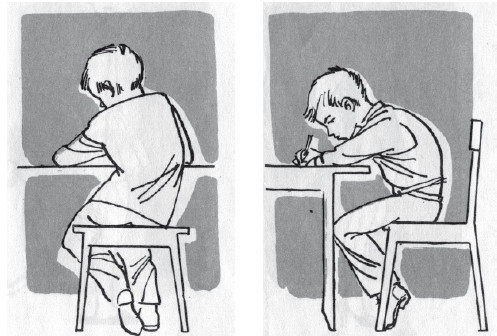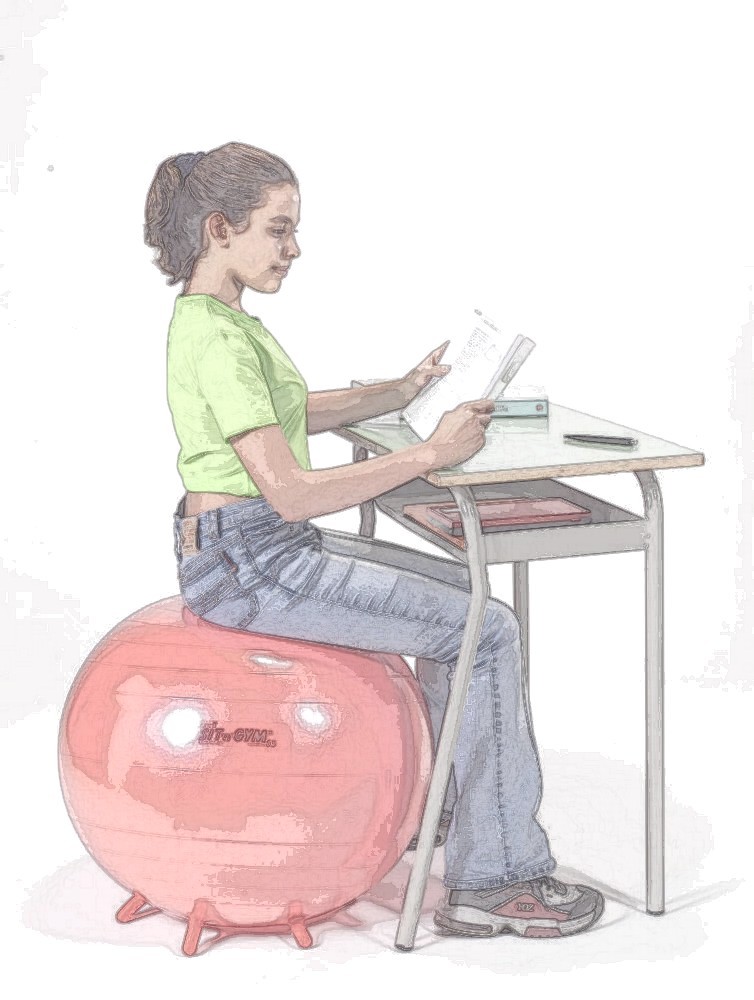Proprioception for non-specialists. Part 3. Dynamic sitting on a chair.
- Tutorial
“A smooth back is a guarantee of health of the spine”, “Sit exactly”, “Your back muscles are weak, they need to be pumped to keep your back even”, “Straighten up what you sit like a hump” - almost every educated person heard these phrases own life.
In fact, aligned with the action of the force of gravity of the Earth, the skeleton will transfer body weight to the fulcrum with minimal muscle tension supporting this skeleton position. And, at the same time, the external characteristic of a correct posture - “a smooth back” - does not at all reflect the processes that are necessary for high-quality sitting or standing.

The main problem of the external static description of “correct posture” is that a living body, constantly balancing in the field of gravity, appears to be a frozen statue, where appearance, rather than internal content, is important. The statues have a massive base that keeps the statue from tipping over, the living person maintains stability otherwise.
The muscles in our body are designed to move, and even those muscles that are adapted for prolonged exercise in static postures, require periodic rest. With prolonged sedentary work, rest is achieved by changing the posture. "Tired back" - the main symptom of ignoring the principles of dynamic posture adjustment, is a response to muscle overload with excessive static load.
You can tell tales for a long time about what a quality posture is, but it doesn’t reflect at all that personal experience of feeling free and relaxed while sitting. Lesson to relieve tension in the back when sitting will take only 5-7 minutes.
Stand up, walk around the room, sit down in the middle of the chair, legs are arranged so that the knee and hip joints have an angle of about 90 °, the feet are completely on the floor. Feel how your buttocks are resting on a chair, how the loin feels, how your hands are lying, how your legs are on the floor.
Try to gently and slowly raise one buttock above the chair, quite a bit, and slowly lower it into place. Notice how you transfer the weight of the body to another buttock, whether you use the support on the feet to make it easier to move.
Repeat the motion several times and stop. Notice what has changed in your feeling of reliance on the chair. Compare how comfortable your buttocks are in the chair, under which of the buttocks the chair seems softer?
Repeat the motion on the other side.
The same starting position as in situation 1. You shift the knee of one leg slightly forward and return to the starting position.
Note that to move the knee forward, you need to move one half of the pelvis forward, while moving around the fulcrum in the buttock area on the other side.
Similarly, when the knee is moved backwards, half of the pelvis on this side moves backwards.
Feel what happens to the lower back during this movement, do it several times, rest, and repeat on the other side.
Let's combine the movements from situations 1 and 2 into a single whole.
Lift one buttock above the chair and move it forward, lower the buttock on the chair. On the other side, repeat this movement. Now, again, change the side, lift the buttock above the chair and move it backwards, lower the buttock. On the other side, repeat.
Thus, walk the chair several times with the buttocks. Very slowly and gently, paying attention to how weight is transferred to the fulcrum, how your lower back responds to movement, what the head and hands do.
Stop, rest, and notice what has changed in your body. How does the loin feel? How soft is the chair seat surface now? Get up and walk around the room, check out what has ground in your gait?
PS One of the options for finding a comfortable position of the spine when working at the table may be a short-term replacement of the chair with a fitball.

Just do not work like this all the time - an unstable support requires too much effort to maintain posture, but the experience of sitting on a fitball gives you more comfort when using an ordinary chair.
In fact, aligned with the action of the force of gravity of the Earth, the skeleton will transfer body weight to the fulcrum with minimal muscle tension supporting this skeleton position. And, at the same time, the external characteristic of a correct posture - “a smooth back” - does not at all reflect the processes that are necessary for high-quality sitting or standing.

The main problem of the external static description of “correct posture” is that a living body, constantly balancing in the field of gravity, appears to be a frozen statue, where appearance, rather than internal content, is important. The statues have a massive base that keeps the statue from tipping over, the living person maintains stability otherwise.
The muscles in our body are designed to move, and even those muscles that are adapted for prolonged exercise in static postures, require periodic rest. With prolonged sedentary work, rest is achieved by changing the posture. "Tired back" - the main symptom of ignoring the principles of dynamic posture adjustment, is a response to muscle overload with excessive static load.
You can tell tales for a long time about what a quality posture is, but it doesn’t reflect at all that personal experience of feeling free and relaxed while sitting. Lesson to relieve tension in the back when sitting will take only 5-7 minutes.
Situation 1
Stand up, walk around the room, sit down in the middle of the chair, legs are arranged so that the knee and hip joints have an angle of about 90 °, the feet are completely on the floor. Feel how your buttocks are resting on a chair, how the loin feels, how your hands are lying, how your legs are on the floor.
Try to gently and slowly raise one buttock above the chair, quite a bit, and slowly lower it into place. Notice how you transfer the weight of the body to another buttock, whether you use the support on the feet to make it easier to move.
Repeat the motion several times and stop. Notice what has changed in your feeling of reliance on the chair. Compare how comfortable your buttocks are in the chair, under which of the buttocks the chair seems softer?
Repeat the motion on the other side.
Situation 2
The same starting position as in situation 1. You shift the knee of one leg slightly forward and return to the starting position.
Note that to move the knee forward, you need to move one half of the pelvis forward, while moving around the fulcrum in the buttock area on the other side.
Similarly, when the knee is moved backwards, half of the pelvis on this side moves backwards.
Feel what happens to the lower back during this movement, do it several times, rest, and repeat on the other side.
Situation 3
Let's combine the movements from situations 1 and 2 into a single whole.
Lift one buttock above the chair and move it forward, lower the buttock on the chair. On the other side, repeat this movement. Now, again, change the side, lift the buttock above the chair and move it backwards, lower the buttock. On the other side, repeat.
Thus, walk the chair several times with the buttocks. Very slowly and gently, paying attention to how weight is transferred to the fulcrum, how your lower back responds to movement, what the head and hands do.
Stop, rest, and notice what has changed in your body. How does the loin feel? How soft is the chair seat surface now? Get up and walk around the room, check out what has ground in your gait?
PS One of the options for finding a comfortable position of the spine when working at the table may be a short-term replacement of the chair with a fitball.

Just do not work like this all the time - an unstable support requires too much effort to maintain posture, but the experience of sitting on a fitball gives you more comfort when using an ordinary chair.
